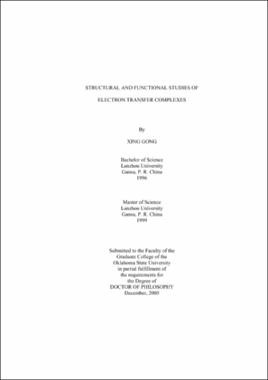| dc.contributor.advisor | Yu, Chang-An | |
| dc.contributor.author | Gong, Xing | |
| dc.date.accessioned | 2013-11-26T08:22:52Z | |
| dc.date.available | 2013-11-26T08:22:52Z | |
| dc.date.issued | 2005-12 | |
| dc.identifier.uri | https://hdl.handle.net/11244/6644 | |
| dc.description.abstract | Scope and Method of Study: As an effort to understand the structure-function relationship of the electron transfer complexes, we chose Escherichia coli and Rhodobacter sphaeroides to study NADH:ubiquinone oxidoreductase (Complex I) and cytochrome bc1 complex (Complex III), respectively. The mechanism of electron transfer and its coupling to proton translocation in Complex I is poorly understood. Knowledge of ubiquinone (Q) binding is essential for mechanistic studies for this enzyme. We identified a Q-binding peptide of NuoM in E. coli complex I by photoaffinity labeling with a photoactivatable azido derivative. One of most unexpected findings in the structural analysis of mitochondrial bc1 complexes is the inter-monomer bL-bL electron transfer during the catalysis. We obtained the evidence for electron equilibrium between the two hemes bL through the molecular genetic manipulation of R. sphaeroides bc1 complex together with biochemical and biophysical measurements. Although bacterial bc1 complexes have simpler subunit composition than their mitochondrial counter parts, the sizes of core subunits are generally larger. We probed the role of one of extra fragments of cytochrome b (residues 309-326) through site-directed mutagenesis at various positions of this fragment in R. sphaeroides bc1 complex. The interaction between cytochrome caa3 and F1F0-ATP synthase from alkaliphilic Bacillus pseudofirmus OF4 was studied by differential scanning calorimetry (DSC) and saturation transfer electron paramagnetic resonance (ST-EPR). | |
| dc.description.abstract | Findings and Conclusions: The photoaffinity labeling results suggest that the Q-binding peptide corresponds to amino acid residues 184-206 of subunit NuoM in E. coli complex I. This Q-binding site is located in the transmembrane helix 5 toward the cytoplasmic side of the membrane or in helix toward the periplasmic side of the membrane depending on the secondary structures of NuoM predicted by different programs. Molecular genetic studies of R. sphaeroides bc1 complex demonstrate the aromatic group at position 195 of cytochrome b is involved in electron transfer reaction of the bc1 complex. The rate of superoxide anion generation is 3 times higher in the F195A complex than in the wild-type, suggesting the idea that the interruption of electron transfer between the two bL hemes enhances electron leakage to oxygen and thus decreases the bc1 activity. The extra fragment of R. sphaeroides cytochrome b (residues 309-326) is found to be involved in the structural stability of the Qo site in the bc1 complex. The results of DSC and ST-EPR indicate that at least a part of cytochrome caa3 and a part of F1F0-ATP synthase form a supermacromolecular complex in the membrane of alkaliphilic Bacillus pseudofirmus OF4. | |
| dc.format | application/pdf | |
| dc.language | en_US | |
| dc.rights | Copyright is held by the author who has granted the Oklahoma State University Library the non-exclusive right to share this material in its institutional repository. Contact Digital Library Services at lib-dls@okstate.edu or 405-744-9161 for the permission policy on the use, reproduction or distribution of this material. | |
| dc.title | Structural and functional studies of electron transfer complexes | |
| dc.contributor.committeeMember | Yu, Linda | |
| dc.contributor.committeeMember | Matts, Robert L. | |
| dc.contributor.committeeMember | Essenberg, Richard C. | |
| dc.contributor.committeeMember | Burnaps, Robert L. | |
| osu.filename | Gong_okstate_0664D_1590.pdf | |
| osu.accesstype | Open Access | |
| dc.type.genre | Dissertation | |
| dc.type.material | Text | |
| thesis.degree.discipline | Biochemistry and Molecular Biology | |
| thesis.degree.grantor | Oklahoma State University | |
